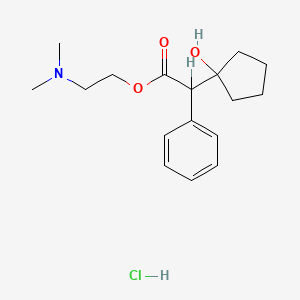



1. Cyclogyl
2. Cyclopentolate
1. 5870-29-1
2. Cyclopentolate Hcl
3. Cyplegin
4. Cyclogyl
5. 2-(dimethylamino)ethyl 2-(1-hydroxycyclopentyl)-2-phenylacetate Hydrochloride
6. Ak-pentolate
7. Mydrilate
8. Pentolair
9. Cyclopentolate (hydrochloride)
10. Cyclopentolatehcl
11. 5870-29-1 (hcl)
12. Mls000069583
13. Chebi:4025
14. Beta-dimethylaminoethyl (1-hydroxycyclopentyl)phenylacetate Hydrochloride
15. 2-(dimethylamino)ethyl 1-hydroxy-alpha-phenylcyclopentaneacetate Hydrochloride
16. 2-(dimethylamino)ethyl 2-(1-hydroxycyclopentyl)-2-phenylacetate;hydrochloride
17. Cyclopentolate For System Suitability
18. Cylate
19. Nsc-756706
20. 60452-44-0
21. Akpentolate
22. Smr000058810
23. Zyklolat
24. 60452-46-2
25. 2-(dimethylamino)ethyl (+-)-1-hydroxy-alpha-phenylcyclopentaneacetate Hydrochloride
26. Dsstox_cid_25390
27. Dsstox_rid_80847
28. Dsstox_gsid_45390
29. Cicloplegicedol
30. Ciclolux
31. Skiacol
32. Alnide
33. 0uxd5v5g6v
34. 6d6x07d6bn
35. Tsiklopentolat Hydrochloride;cyclogyl Hydrochloride;dl-cyclopentolate Hydrochloride
36. Benzeneacetic Acid, Alpha-(1-hydroxycyclopentyl)-, 2-(dimethylamino)ethyl Ester, Hydrochloride, (-)-
37. Cyclopentolate Hydrochloride, (+)-
38. Cyclopentolate Hydrochloride, (-)-
39. 736i6971te
40. Einecs 227-521-8
41. Sr-01000003121
42. Unii-736i6971te
43. Cyclogyl (tn)
44. Cyclopentolate Hydrochloride [usp:jan]
45. Opera_id_69
46. Ncgc00016661-01
47. (+-)-cyclopentolate Hcl
48. Unii-0uxd5v5g6v
49. 2-(2-(1-hydroxycyclopentyl)-2-phenylacetoxy)ethyldimethylammonium Chloride
50. Cas-5870-29-1
51. Crimson Glory Rose Resinoid
52. Unii-6d6x07d6bn
53. Schembl24612
54. Mls001148637
55. Mls001332539
56. Mls001332540
57. Spectrum1500212
58. Regid_for_cid_22162
59. Cyclopentolate Hcl;ak-pentolate
60. Chembl1200473
61. Dtxsid9045390
62. Hy-b1621a
63. Hms1571k12
64. Hms1920a22
65. Pharmakon1600-01500212
66. Amy23400
67. Bcp21337
68. Einecs 262-240-4
69. Einecs 262-242-5
70. Tox21_110550
71. Ccg-39635
72. Mfcd00079048
73. Nsc756706
74. S5921
75. 2-(dimethylamino)ethyl (+)-(1-hydroxycyclopentyl)phenylacetate Hydrochloride
76. Akos015901379
77. Tox21_110550_1
78. Nsc 756706
79. Benzeneacetic Acid, Alpha-(1-hydroxycyclopentyl)-, 2-(dimethylamino)ethyl Ester, Hydrochloride
80. Cyclopentaneacetic Acid, 1-hydroxy-alpha-phenyl-, 2-(dimethylamino)ethyl Ester, Hydrochloride
81. Cyclopentolate Hydrochloride (jp17/usp)
82. Ncgc00018213-06
83. Ncgc00094635-01
84. Ncgc00094635-02
85. Ncgc00094635-03
86. Ncgc00094635-04
87. Ac-27486
88. As-49330
89. Benzeneacetic Acid, Alpha-(1-hydroxycyclopentyl)-, 2-(dimethylamino)ethyl Ester, Hydrochloride, (+-)-
90. Db-053247
91. Cs-0013554
92. Ft-0603161
93. D01002
94. H10247
95. 870c291
96. Sr-01000003121-4
97. Q27266147
98. 2-(dimethylamino)ethyl (1-hydroxycyclopentyl)(phenyl)acetate Hydrochloride
99. Cyclopentolate Hydrochloride, European Pharmacopoeia (ep) Reference Standard
100. 2-(dimethylamino)ethyl (-)-(1-hydroxycyclopentyl)phenylacetate Hydrochloride
101. 2-(dimethylamino)ethyl 2-(1-hydroxycyclopentyl)-2-phenylacetate;hydron;chloride
102. 2-dimethylaminoethyl 1-hydroxy-
103. A-phenylcyclopentaneacetate,cyclopentolate Hydrochloride
104. Alpha-(1-hydroxycyclopentyl)benzeneacetic Acid 2-(dimethylamino)ethyl Ester Hydrochloride
105. Cyclopentolate For System Suitability, European Pharmacopoeia (ep) Reference Standard
106. Cyclopentolate Hydrochloride, United States Pharmacopeia (usp) Reference Standard
107. Benzeneacetic Acid, .alpha.-(1-hydroxycyclopentyl)-, 2-(dimethylamino)ethyl Ester, Hydrochloride (1:1)
108. Benzeneacetic Acid,
109. A-(1-hydroxycyclopentyl)-, 2-(dimethylamino)ethyl Ester, Hydrochloride, (-)-
| Molecular Weight | 327.8 g/mol |
|---|---|
| Molecular Formula | C17H26ClNO3 |
| Hydrogen Bond Donor Count | 2 |
| Hydrogen Bond Acceptor Count | 4 |
| Rotatable Bond Count | 7 |
| Exact Mass | 327.1601214 g/mol |
| Monoisotopic Mass | 327.1601214 g/mol |
| Topological Polar Surface Area | 49.8 Ų |
| Heavy Atom Count | 22 |
| Formal Charge | 0 |
| Complexity | 331 |
| Isotope Atom Count | 0 |
| Defined Atom Stereocenter Count | 0 |
| Undefined Atom Stereocenter Count | 1 |
| Defined Bond Stereocenter Count | 0 |
| Undefined Bond Stereocenter Count | 0 |
| Covalently Bonded Unit Count | 2 |
| 1 of 4 | |
|---|---|
| Drug Name | Akpentolate |
| Active Ingredient | Cyclopentolate hydrochloride |
| Dosage Form | Solution/drops |
| Route | Ophthalmic |
| Strength | 1% |
| Market Status | Prescription |
| Company | Akorn |
| 2 of 4 | |
|---|---|
| Drug Name | Pentolair |
| Active Ingredient | Cyclopentolate hydrochloride |
| Dosage Form | Solution/drops |
| Route | Ophthalmic |
| Strength | 1% |
| Market Status | Prescription |
| Company | Bausch And Lomb |
| 3 of 4 | |
|---|---|
| Drug Name | Akpentolate |
| Active Ingredient | Cyclopentolate hydrochloride |
| Dosage Form | Solution/drops |
| Route | Ophthalmic |
| Strength | 1% |
| Market Status | Prescription |
| Company | Akorn |
| 4 of 4 | |
|---|---|
| Drug Name | Pentolair |
| Active Ingredient | Cyclopentolate hydrochloride |
| Dosage Form | Solution/drops |
| Route | Ophthalmic |
| Strength | 1% |
| Market Status | Prescription |
| Company | Bausch And Lomb |
Muscarinic Antagonists
Drugs that bind to but do not activate MUSCARINIC RECEPTORS, thereby blocking the actions of endogenous ACETYLCHOLINE or exogenous agonists. Muscarinic antagonists have widespread effects including actions on the iris and ciliary muscle of the eye, the heart and blood vessels, secretions of the respiratory tract, GI system, and salivary glands, GI motility, urinary bladder tone, and the central nervous system. (See all compounds classified as Muscarinic Antagonists.)
Parasympatholytics
Agents that inhibit the actions of the parasympathetic nervous system. The major group of drugs used therapeutically for this purpose is the MUSCARINIC ANTAGONISTS. (See all compounds classified as Parasympatholytics.)
Mydriatics
Agents that dilate the pupil. They may be either sympathomimetics or parasympatholytics. (See all compounds classified as Mydriatics.)